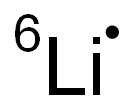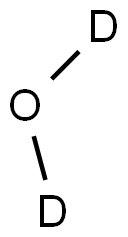Lithium deuteride
Synonym(s):Lithium hydride-d
- CAS NO.:13587-16-1
- Empirical Formula: DLi
- Molecular Weight: 8.96
- MDL number: MFCD00011091
- EINECS: 237-018-5
- SAFETY DATA SHEET (SDS)
- Update Date: 2024-09-03 18:36:42

What is Lithium deuteride?
Chemical properties
Lithium deuteride at ambient has the NaCl (rock salt) structure: two interlaced FCC lattices; 5 eV band gap: single crystal samples are transparent.
Lithium deuteride come in single crystals, (packed) powders, or pressed into cakes.
The Uses of Lithium deuteride
Lithium deuteride is an isotopically labeled derivative of lithium hydride, Used in thermonuclear fusion; Used as the explosive in the hydrogen bomb and used for hydrogen storage and also in the synthesis of rocket fuel.
Preparation
Lithium deuteride has been prepared by the direct combination of lithium and deuterium at 700°, the deuterium having been obtained from the oxide by the use of magnesium.
The laboratory preparation of lithium deuteride and lithium aluminium deuteride
General Description
Lithium deuteride (LiD) is a stable isotopic compound that is commonly used in deuterium storage and energy storage applications because of its high melting point, low density, high deuterium concentration, and exceptional thermal stability in both vacuum and inert gases. It can also be used as a potential raw material for the synthesis of organic deuterides, deuterated solvents, and deuterated polymers.
Properties of Lithium deuteride
| Melting point: | 680 °C |
| Density | 0.82 |
| storage temp. | water-free area |
| solubility | reacts with H2O |
| form | Powder |
| Specific Gravity | 0.82 |
| color | Gray |
| Sensitive | Air & Moisture Sensitive |
Safety information for Lithium deuteride
| Signal word | Danger |
| Pictogram(s) |
 Flame Flammables GHS02  Corrosion Corrosives GHS05 |
| GHS Hazard Statements |
H260:Substances And Mixtures Which, In Contact With Water,Emit Flammable Gases H314:Skin corrosion/irritation |
| Precautionary Statement Codes |
P223:Keep away from any possible contact with water, because of violent reaction and possible flash fire. P260:Do not breathe dust/fume/gas/mist/vapours/spray. P280:Wear protective gloves/protective clothing/eye protection/face protection. P231+P232:Handle under inert gas. Protect from moisture. P303+P361+P353:IF ON SKIN (or hair): Remove/Take off Immediately all contaminated clothing. Rinse SKIN with water/shower. P305+P351+P338:IF IN EYES: Rinse cautiously with water for several minutes. Remove contact lenses, if present and easy to do. Continuerinsing. |
Computed Descriptors for Lithium deuteride
| InChIKey | SIAPCJWMELPYOE-IEOVAKBOSA-N |
New Products
(S)-3-Aminobutanenitrile hydrochloride 4-Methylphenylacetic acid N-Boc-D-alaninol N-BOC-D/L-ALANINOL Tert-butyl bis(2-chloroethyl)carbamate 3-Morpholino-1-(4-nitrophenyl)-5,6-dihydropyridin- 2(1H)-one Furan-2,5-Dicarboxylic Acid Tropic acid 1-Bromo-3,5-Di-Tert-Butylbenzene S-2-CHLORO PROPIONIC ACID ETHYL ISOCYANOACETATE 2-Bromo-1,3-Bis(Dimethylamino)Trimethinium Hexafluorophosphate 4-IODO BENZOIC ACID 3-NITRO-2-METHYL ANILINE 1-(2,4-DICHLOROPHENYL) ETHANAMINE (2-Hydroxyphenyl)acetonitrile 4-Bromopyrazole 2-(Cyanocyclohexyl)acetic acid 4-methoxy-3,5-dinitropyridine 1-(4-(aminomethyl)benzyl)urea hydrochloride 2-aminopropyl benzoate hydrochloride diethyl 2-(2-((tertbutoxycarbonyl)amino) ethyl)malonate tert-butyl 4- (ureidomethyl)benzylcarbamate Ethyl-2-chloro((4-methoxyphenyl)hydrazono)acetateRelated products of tetrahydrofuran








You may like
-
 2033-24-1 98%View Details
2033-24-1 98%View Details
2033-24-1 -
 42831-50-5 5-METHYLISOXAZOLE-4-CARBOXYLIC ACID 98%View Details
42831-50-5 5-METHYLISOXAZOLE-4-CARBOXYLIC ACID 98%View Details
42831-50-5 -
 1975-50-4 98%View Details
1975-50-4 98%View Details
1975-50-4 -
 2-HYDROXY BENZYL ALCOHOL 98%View Details
2-HYDROXY BENZYL ALCOHOL 98%View Details
90-01-7 -
 2-Chloro-1,3-Bis(Dimethylamino)Trimethinium Hexafluorophosphate 221615-75-4 98%View Details
2-Chloro-1,3-Bis(Dimethylamino)Trimethinium Hexafluorophosphate 221615-75-4 98%View Details
221615-75-4 -
 61397-56-6 CIS BROMO BENZOATE 98%View Details
61397-56-6 CIS BROMO BENZOATE 98%View Details
61397-56-6 -
 14714-50-2 (2-Hydroxyphenyl)acetonitrile 98+View Details
14714-50-2 (2-Hydroxyphenyl)acetonitrile 98+View Details
14714-50-2 -
 118753-70-1 98+View Details
118753-70-1 98+View Details
118753-70-1